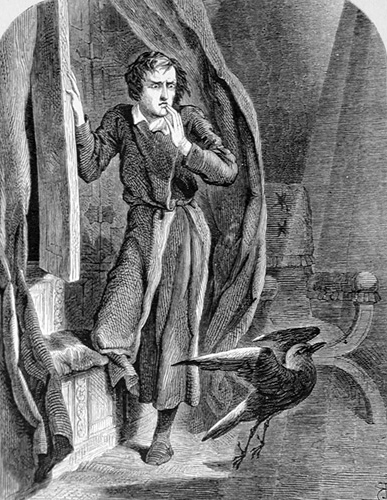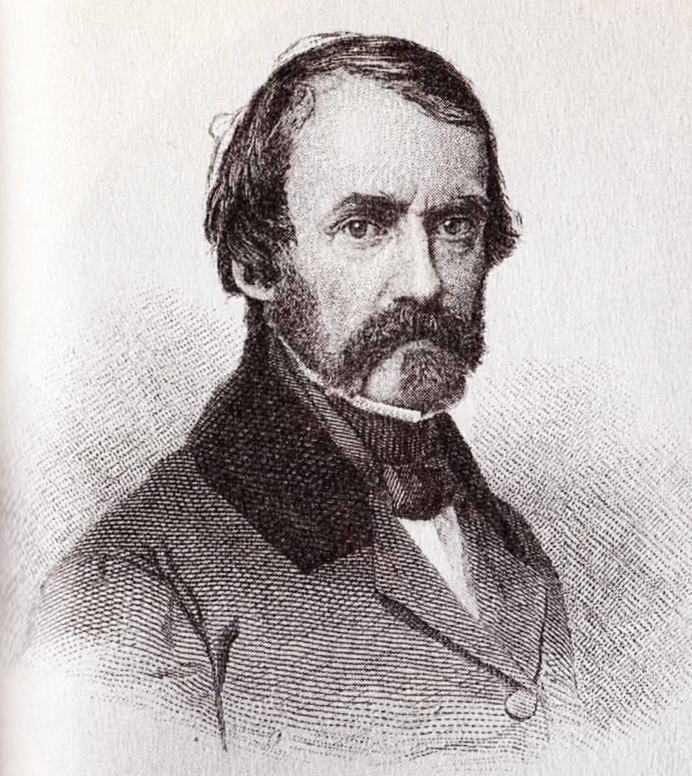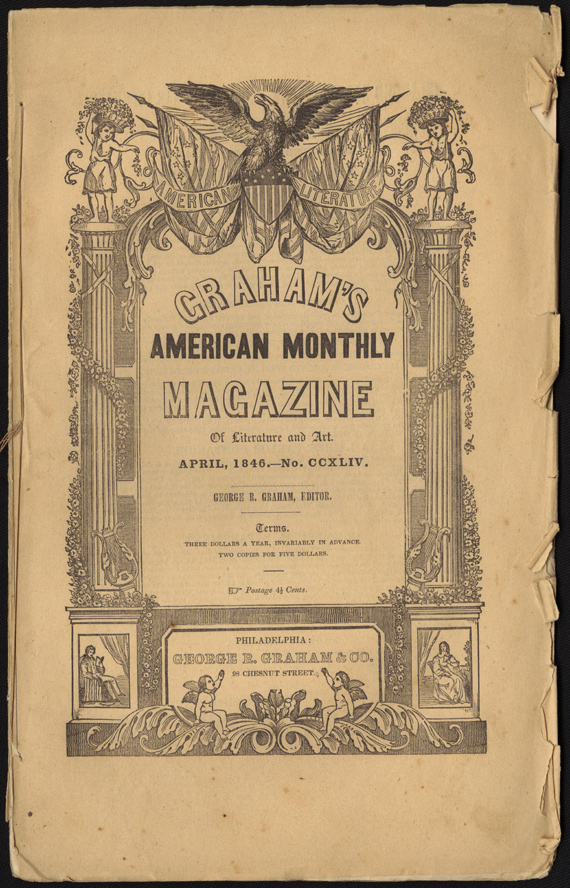|
Eulalie
"Eulalie," or "Eulalie — A Song," is a poem by Edgar Allan Poe, first published in the July 1845 issue of '' The American Review'' and reprinted shortly thereafter in the August 9, 1845 issue of the ''Broadway Journal''. Summary The poem is a bridal song about a man who overcomes his sadness by marrying the beautiful Eulalie. The woman's love here has a transformative effect on the narrator, taking him from a "world of moan" to one of happiness. Analysis The poem uses Poe's frequent theme of " the death of a beautiful woman," which he considered to be "the most poetical topic in the world." The use of this theme has often been suggested to be autobiographical by Poe critics and biographers, stemming from the repeated loss of women throughout Poe's life, including his mother Eliza Poe and his foster mother Frances Allan. If autobiographical, "Eulalie" may be referring to Poe's relationship with his wife Virginia. It seems to express that she lifted his spirits and washed away hi ... [...More Info...] [...Related Items...] OR: [Wikipedia] [Google] [Baidu] |
Poems By Edgar Allan Poe
This article lists all known poems by American author and critic Edgar Allan Poe (January 19, 1809 – October 7, 1849), listed alphabetically with the date of their authorship in parentheses. An Acrostic (1829) An unpublished 9-line poem written circa 1829 for Poe's cousin Elizabeth Rebecca Herring (the acrostic is her first name, spelled out by the first letter of each line). It was never published in Poe's lifetime. James H. Whitty discovered the poem and included it in his 1911 anthology of Poe's works under the title "From an Album". It was also published in Thomas Ollive Mabbott's definitive ''Collected Works of Edgar Allan Poe'' in 1969 as "An Acrostic". The poem mentions "Endymion", possibly referring to an 1818 poem by John Keats with that name. The "L. E. L." in the third line may be Letitia Elizabeth Landon, an English artist known for signing her work with those initials. "Zantippe" in line four is actually Xanthippe, wife of Socrates. The spelling of the name was ch ... [...More Info...] [...Related Items...] OR: [Wikipedia] [Google] [Baidu] |
Poetry By Edgar Allan Poe
This article lists all known poems by American author and critic Edgar Allan Poe (January 19, 1809 – October 7, 1849), listed alphabetically with the date of their authorship in parentheses. An Acrostic (1829) An unpublished 9-line poem written circa 1829 for Poe's cousin Elizabeth Rebecca Herring (the acrostic is her first name, spelled out by the first letter of each line). It was never published in Poe's lifetime. James H. Whitty discovered the poem and included it in his 1911 anthology of Poe's works under the title "From an Album". It was also published in Thomas Ollive Mabbott's definitive ''Collected Works of Edgar Allan Poe'' in 1969 as "An Acrostic". The poem mentions "Endymion", possibly referring to an 1818 poem by John Keats with that name. The "L. E. L." in the third line may be Letitia Elizabeth Landon, an English artist known for signing her work with those initials. "Zantippe" in line four is actually Xanthippe, wife of Socrates. The spelling of the name was ch ... [...More Info...] [...Related Items...] OR: [Wikipedia] [Google] [Baidu] |
Lenore (poem)
"Lenore" is a poem by the American author Edgar Allan Poe. It began as a different poem, "A Paean", and was not published as "Lenore" until 1843. Analysis The poem discusses proper decorum in the wake of the death of a young woman, described as "the queenliest dead that ever died so young". The poem concludes: "No dirge shall I upraise,/ But waft the angel on her flight with a paean of old days!" Lenore's fiancé, Guy de Vere, finds it inappropriate to "mourn" the dead; rather, one should celebrate their ascension to a new world. Unlike most of Poe's poems relating to dying women, "Lenore" implies the possibility of meeting in paradise. The poem may have been Poe's way of dealing with the illness of his wife Virginia. The dead woman's name, however, may have been a reference to Poe's recently dead brother, William Henry Leonard Poe. Poetically, the name Lenore emphasizes the letter " L" sound, a frequent device in Poe's female characters including "Annabel Lee", "Eulalie", a ... [...More Info...] [...Related Items...] OR: [Wikipedia] [Google] [Baidu] |
Edgar Allan Poe
Edgar Allan Poe (; Edgar Poe; January 19, 1809 – October 7, 1849) was an American writer, poet, editor, and literary critic. Poe is best known for his poetry and short stories, particularly his tales of mystery and the macabre. He is widely regarded as a central figure of Romanticism in the United States, and of American literature. Poe was one of the country's earliest practitioners of the short story, and considered to be the inventor of the detective fiction genre, as well as a significant contributor to the emerging genre of science fiction. Poe is the first well-known American writer to earn a living through writing alone, resulting in a financially difficult life and career. Poe was born in Boston, the second child of actors David and Elizabeth "Eliza" Poe. His father abandoned the family in 1810, and when his mother died the following year, Poe was taken in by John and Frances Allan of Richmond, Virginia. They never formally adopted him, but he was with them well ... [...More Info...] [...Related Items...] OR: [Wikipedia] [Google] [Baidu] |
Annabel Lee
"Annabel Lee" is the last complete poem composed by American author Edgar Allan Poe. Like many of Poe's poems, it explores the theme of the death of a beautiful woman.Meyers, Jeffrey. ''Edgar Allan Poe: His Life and Legacy''. New York: Cooper Square Press, 1992. p. 243. The narrator, who fell in love with Annabel Lee when they were young, has a love for her so strong that even angels are envious. He retains his love for her even after her death. There has been debate over who, if anyone, was the inspiration for "Annabel Lee". Though many women have been suggested, Poe's wife Virginia Eliza Clemm Poe is one of the more credible candidates. Written in 1849, it was not published until shortly after Poe's death that same year. Synopsis The poem's narrator describes his love for Annabel Lee, which began many years ago in a "kingdom by the sea". Though they were young, their love for one another burned with such intensity that even angels were envious. For this reason the narrator beli ... [...More Info...] [...Related Items...] OR: [Wikipedia] [Google] [Baidu] |
Ulalume
"Ulalume" () is a poem written by Edgar Allan Poe in 1847. Much like a few of Poe's other poems (such as " The Raven", " Annabel Lee", and " Lenore"), "Ulalume" focuses on the narrator's loss of his beloved due to her death. Poe originally wrote the poem as an elocution piece and, as such, the poem is known for its focus on sound. Additionally, it makes many allusions, especially to mythology, and the identity of Ulalume herself, if a real person, has been a subject of debate. Overview The poem takes place on a night in the "lonesome October" with a gray sky as the leaves are withering for the autumn season. In the region of Weir, by the lake of Auber, the narrator roams with a "volcanic" heart. He has a "serious and sober" talk with his soul, though he does not realize it is October or where his roaming is leading him. He remarks on the stars as night fades away, remarking on the brightest one, and wonders if it knows that the tears on his cheeks have not yet dried. His soul, how ... [...More Info...] [...Related Items...] OR: [Wikipedia] [Google] [Baidu] |
The Raven
"The Raven" is a narrative poem by American writer Edgar Allan Poe. First published in January 1845, the poem is often noted for its musicality, stylized language, and supernatural atmosphere. It tells of a distraught lover who is paid a mysterious visit by a talking raven. The lover, often identified as a student,Meyers, 163Silverman, 239 is lamenting the loss of his love, Lenore. Sitting on a bust of Pallas, the raven seems to further antagonize the protagonist with its constant repetition of the word "Nevermore". The poem makes use of folk, mythological, religious, and classical references. Poe claimed to have written the poem logically and methodically, with the intention to create a poem that would appeal to both critical and popular tastes, as he explained in his 1846 follow-up essay, "The Philosophy of Composition". The poem was inspired in part by a talking raven in the novel '' Barnaby Rudge: A Tale of the Riots of Eighty'' by Charles Dickens.Kopley & Hayes, 192 Poe ... [...More Info...] [...Related Items...] OR: [Wikipedia] [Google] [Baidu] |
A Whig Journal
A, or a, is the first letter and the first vowel of the Latin alphabet, used in the modern English alphabet, the alphabets of other western European languages and others worldwide. Its name in English is ''a'' (pronounced ), plural ''aes''. It is similar in shape to the Ancient Greek letter alpha, from which it derives. The uppercase version consists of the two slanting sides of a triangle, crossed in the middle by a horizontal bar. The lowercase version can be written in two forms: the double-storey a and single-storey ɑ. The latter is commonly used in handwriting and fonts based on it, especially fonts intended to be read by children, and is also found in italic type. In English grammar, " a", and its variant " an", are indefinite articles. History The earliest certain ancestor of "A" is aleph (also written 'aleph), the first letter of the Phoenician alphabet, which consisted entirely of consonants (for that reason, it is also called an abjad to distinguish it fro ... [...More Info...] [...Related Items...] OR: [Wikipedia] [Google] [Baidu] |
Broadway Journal
The ''Broadway Journal'' was a short-lived New York City-based newspaper founded by Charles Frederick Briggs and John Bisco in 1844 and was published from January 1845 to January 1846. In its first year, the publication was bought by Edgar Allan Poe, becoming the only periodical he ever owned, though it failed after only a few months under his leadership. History Briggs, previously known as a satire novelist under the pseudonym "Harry Franco", wrote a letter to James Russell Lowell on December 7, 1844, announcing his intentions to start a journal. "The name will be, for the sake of individuality and a-part-from-other-peopleness, the Broadway Journal, or Review, or Chronicle, or Broadway Something". Upon its founding as the ''Broadway Journal'', Briggs handled the editorial duties and solicited for contributors while his business partner John Bisco handled the publishing and financial concerns. On February 21, 1845, Edgar Allan Poe signed a year-long contract to become an editor ... [...More Info...] [...Related Items...] OR: [Wikipedia] [Google] [Baidu] |
The Philosophy Of Composition
"The Philosophy of Composition" is an 1846 essay written by American writer Edgar Allan Poe that elucidates a theory about how good writers write when they write well. He concludes that length, "unity of effect" and a logical method are important considerations for good writing. He also makes the assertion that "the death... of a beautiful woman" is "unquestionably the most poetical topic in the world". Poe uses the composition of his own poem "The Raven" as an example. The essay first appeared in the April 1846 issue of ''Graham's Magazine''. It is uncertain if it is an authentic portrayal of Poe's own method. Poe's philosophy of composition Generally, the essay introduces three of Poe's theories regarding literature. The author recounts this idealized process by which he says he wrote his most famous poem, "The Raven", to illustrate the theory, which is in deliberate contrast to the "spontaneous creation" explanation put forth, for example, by Coleridge as an explanation for his ... [...More Info...] [...Related Items...] OR: [Wikipedia] [Google] [Baidu] |
Eliza Poe
Eliza Poe ( Elizabeth Arnold; formerly Hopkins; 1787 – December 8, 1811) was an English actress and the mother of the American author Edgar Allan Poe. Life and career Elizabeth Arnold was born to Henry and Elizabeth Arnold in London in the spring of 1787.Sova, 192 Her mother was a stage actress in London from 1791 to 1795. Henry is thought to have died in 1790 and, in November 1795, only mother and daughter sailed from England to the United States, arriving in Boston, Massachusetts, on January 3, 1796. Arnold debuted on the Boston stage at the age of nine, only three months after her arrival in the United States.Meyers, 2 She played a character named Biddy Blair in David Garrick's farce ''Miss in Her Teens'' and was praised in the ''Portland Herald'': "Miss Arnold, in Miss Biddy, exceeded all praise.. Although a miss of only nine years old, her powers as an Actress will do credit to any of her sex of maturer age". Later that year, Elizabeth married musician Charles Tubbs, ... [...More Info...] [...Related Items...] OR: [Wikipedia] [Google] [Baidu] |







